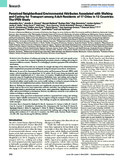Mostrar el registro sencillo del ítem
Perceived neighborhood environmental attributes associated with walking and cycling for transport among adult residents of 17 cities in 12 countries: the IPEN study
| dc.creator | Kerr, Jacqueline | es_ES |
| dc.creator | Emond, Jennifer A. | es_ES |
| dc.creator | Badland, Hannah | es_ES |
| dc.creator | Reis, Rodrigo S. | es_ES |
| dc.creator | Sarmiento, Olga L. | es_ES |
| dc.creator | Carlson, Jordan | es_ES |
| dc.creator | Sallis, James F. | es_ES |
| dc.creator | Cerin, Ester | es_ES |
| dc.creator | Cain, Kelli L. | es_ES |
| dc.creator | Aguinaga Ontoso, Inés | es_ES |
| dc.date.accessioned | 2019-01-21T13:24:49Z | |
| dc.date.available | 2019-01-21T13:24:49Z | |
| dc.date.issued | 2016 | |
| dc.identifier.citation | Kerr J, Emond JA, Badland H, Reis R, Sarmiento O, Carlson J, Sallis JF, Cerin E, Cain K, Conway T, Schofield G, Macfarlane DJ, Christiansen LB, Van Dyck D, Davey R, Aguinaga-Ontoso I, Salvo D, Sugiyama T, Owen N, Mitáš J, Natarajan L. 2016. Perceived neighborhood environmental attributes associated with walking and cycling for transport among adult residents of 17 cities in 12 countries: the IPEN study. Environ Health Perspect 124:290–298; http://dx.doi.org/10.1289/ehp.1409466 | en |
| dc.identifier.issn | 0091-6765 (Print) | |
| dc.identifier.issn | 1552-9924 (Electronic) | |
| dc.identifier.uri | https://hdl.handle.net/2454/32039 | |
| dc.description.abstract | Introduction: Prevalence of walking and cycling for transport is low and varies greatly across countries. Few studies have examined neighborhood perceptions related to walking and cycling for transport in different countries. Therefore, it is challenging to prioritize appropriate built-environment interventions. Objectives: The aim of this study was to examine the strength and shape of the relationship between adults’ neighborhood perceptions and walking and cycling for transport across diverse environments. Methods: As part of the International Physical activity and Environment Network (IPEN) adult project, self-reported data were taken from 13,745 adults (18–65 years) living in physically and socially diverse neighborhoods in 17 cities across 12 countries. Neighborhood perceptions were measured using the Neighborhood Environment Walkability Scale, and walking and cycling for transport were measured using the International Physical Activity Questionnaire–Long Form. Generalized additive mixed models were used to model walking or cycling for transport during the last seven days with neighborhood perceptions. Interactions by city were explored. Results: Walking-for-transport outcomes were significantly associated with perceived residential density, land use mix–access, street connectivity, aesthetics, and safety. Any cycling for transport was significantly related to perceived land use mix–access, street connectivity, infrastructure, aesthetics, safety, and perceived distance to destinations. Between-city differences existed for some attributes in relation to walking or cycling for transport. Conclusions: Many perceived environmental attributes supported both cycling and walking; however, highly walkable environments may not support cycling for transport. People appear to walk for transport despite safety concerns. These findings can guide the implementation of global health strategies. | en |
| dc.format.extent | 9 p. | |
| dc.format.mimetype | application/pdf | en |
| dc.format.mimetype | application/zip | en |
| dc.language.iso | eng | en |
| dc.publisher | National Institute of Environmental Health Science | en |
| dc.relation.ispartof | Environmental Health Perspectives, vol. 124, number 3, March 2016 | en |
| dc.rights | Public domain | en |
| dc.subject | Walking for transport | en |
| dc.subject | Cycling for transport | en |
| dc.subject | Neighborhood perceptions | en |
| dc.title | Perceived neighborhood environmental attributes associated with walking and cycling for transport among adult residents of 17 cities in 12 countries: the IPEN study | en |
| dc.type | info:eu-repo/semantics/article | en |
| dc.type | Artículo / Artikulua | es |
| dc.contributor.department | Ciencias de la Salud | es_ES |
| dc.contributor.department | Osasun Zientziak | eu |
| dc.rights.accessRights | info:eu-repo/semantics/openAccess | en |
| dc.rights.accessRights | Acceso abierto / Sarbide irekia | es |
| dc.identifier.doi | 10.1289/ehp.1409466 | |
| dc.relation.publisherversion | https://doi.org/10.1289/ehp.1409466 | |
| dc.type.version | info:eu-repo/semantics/publishedVersion | en |
| dc.type.version | Versión publicada / Argitaratu den bertsioa | es |


